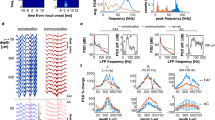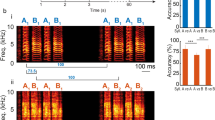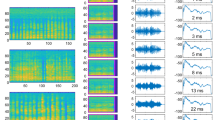Abstract
THE auditory system of the horseshoe bat is finely tuned to the bat's individual vocalization frequency1,2. To compensate for flight-induced Doppler shifts in the echo frequency, the horseshoe bat adjusts the frequency of its echo-location call to maintain the echo frequency within the narrow range to which its auditory system is best tuned3,4. In this report I describe neurons in the midbrain tegmentum of the horseshoe bat, with properties that strongly indicate their involvement in this Doppler-shift compensation. The activity of these neurons was influenced by both sound emission and auditory stimuli. Neuronal discharges in response to vocalization, however, differed from those in response to purely auditory stimuli that mimicked the bat call. When an auditory stimulus was temporally locked to a preceding vocalization, the response was dependent on the time delay between the two. This delay-sensitivity completely disappeared when vocalizations were simulated acoustically. Only those vocalization and 'echo' parameters were encoded that occur in Doppler-shift compensation5–7. In conclusion, I suggest a model for the regulation of the vocalization frequency through auditory feedback.
This is a preview of subscription content, access via your institution
Access options
Subscribe to this journal
Receive 51 print issues and online access
$199.00 per year
only $3.90 per issue
Buy this article
- Purchase on Springer Link
- Instant access to full article PDF
Prices may be subject to local taxes which are calculated during checkout
Similar content being viewed by others
References
Neuweiler, G. Z. vergl. Physiol. 67, 273–306 (1970).
Neuweiler, G. et al. Behavl Ecol. Sociobiol. 20, 53–67 (1987).
Schnitzler, H. U. Z. vergl. Physiol. 57, 376–408 (1968).
Schuller, G., Beuter, K. & Schnitzler, H. U. J. comp. Physiol. 89, 275–286 (1974).
Schuller, G. J. comp. Physiol. A158, 239–246 (1986).
Schuller, G. J. comp. Physiol. 114, 103–114 (1977).
Schuller, G., Beuter, K. & Rubsamen, R. J. comp. Physiol. 97, 113–125 (1975).
Schuller, G. & Pollak, G. D. J. comp. Physiol. 132, 47–54 (1979).
Schuller, G. & Rübsamen, R. J. comp. Physiol. 143, 317–321 (1981).
Schuller, G. & Radtke-Schuller, S. in The Physiological Control of Mammalian Vocalization (ed. Newmann, J.) 67–85 (Plenum, New York, 1989).
Suga, N., Schlegel, P., Shimozawa, T. & Simmons, J. J. acoust. Soc. Am. 54, 793–797 (1973).
Kelly, A. H., Beaton, L. E. & Magoun, H. W. J. Neurophysiol. 9, 181–189 (1946).
Magoun, H. W., Atlas, D., Ingersoll, E. H. & Ranson, S. W. J. Neurol. Psychopathol. 17, 241–255 (1937).
Metzner, W. in New Frontiers in Brain Research (eds Elsner, N. & Creutzfeldt, O.) 119 (Thieme, Stuttgart and New York, 1987)
Metzner, W. in Dynamics and Plasticity in Neural Systems (eds Elsner, N. & Singer, W.) 289 (Thieme, Stuttgart and New York, 1989)
Henkel, C. K. & Edwards, S. B. J. comp. Neurol. 182, 763–776 (1978).
Paxinos, G. & Watson, C. The Rat Brain (Academic, Sydney, 1986).
Panneton, W. M. & Martin, G. F. Brain Res. 168, 493–511 (1979).
Simmons, J. A. J. acoust. Soc. Am. 54, 157–173 (1973).
Rübsamen, R. & Schweizer, H. J. comp. Physiol. A159, 689–699 (1986).
Rübsamen, R. & Betz, M. J. comp. Physiol. A159, 675–687 (1986).
Schuller, G., Radtke-Schuller, S. & Betz, M. J. Neurosci. Meth. 18, 339–350 (1986).
Metzner, W. & Radtke-Schuller, S. J. comp. Physiol. A160, 395–411 (1987).
Pietsch, G. & Schuller, G. J. comp. Physiol A160, 635–644 (1987).
Adams, J. C., Neuroscience 2, 142–145 (1977).
Mesulam, M. M. J. Histochem. Cytochem. 24, 1273–1280 (1978).
Schuller, G. & Suga, N. J. comp. Physiol. 105, 9–14 (1976).
Author information
Authors and Affiliations
Rights and permissions
About this article
Cite this article
Metzner, W. A possible neuronal basis for Doppler-shift compensation in echo-locating horseshoe bats. Nature 341, 529–532 (1989). https://doi.org/10.1038/341529a0
Received:
Accepted:
Issue Date:
DOI: https://doi.org/10.1038/341529a0
This article is cited by
-
Transmitter and receiver of the low frequency horseshoe bat Rhinolophus paradoxolophus are functionally matched for fluttering target detection
Journal of Comparative Physiology A (2023)
-
The tiny difference between foraging and communication buzzes uttered by the Mexican free-tailed bat, Tadarida brasiliensis
Journal of Comparative Physiology A (2007)
-
Echolocation calls and communication calls are controlled differentially in the brainstem of the bat Phyllostomus discolor
BMC Biology (2005)
-
Corollary discharge inhibition and audition in the stridulating cricket
Journal of Comparative Physiology A (2005)
-
A corollary discharge maintains auditory sensitivity during sound production
Nature (2002)
Comments
By submitting a comment you agree to abide by our Terms and Community Guidelines. If you find something abusive or that does not comply with our terms or guidelines please flag it as inappropriate.



